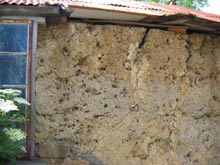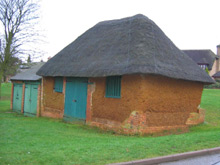|
|
|
|
|
|
|
|
|
|
| |
|
|
|
England has an ancient heritage of earth buildings and it
has well funded bodies whose main focus is the preservation
of this heritage. ICOMOS UK (International Council of Monuments
and Sites) and English Heritage produced a study of earth
building traditions in Great Britain and Ireland titled
“Terra Britannica” in 2000. They were also the main supporters
of “Terra 2000”, an international conference focussed mainly
on the preservation and repair of old earth structures. |
|
|
|
| |
|
|

An old earth wall in Great Easton, Leics. A leaking roof
has allowed erosion so the wall is becoming unstable. |
|
In
an article entitled: “Traditional crafts updated: thatching
and cob”, published in Structural Survey, Vol 13, No 4,
1995, Tony Ley writes:
"It is not uncommon for thatch roofs to have been
removed and replaced by slate, tile or wrinkly tin. The
new roof fails to provide the same overhang as the thatch.
Consequently more rain contacts the surface of the wall,
eventually causing local saturation, resulting in cracking
or partial collapse, especially in the areas of roof or
floor beams. These conditions can be aggravated where tiles
or slates are missing. Once cob reaches saturation level
it moves through the plastic stage quickly and slumps dramatically,
resulting in extensive collapse." |
|
|
|
| |
|
|
English
Heritage had a problem as it was aware that the
stock of old earth dwellings and barns was rapidly dwindling
as lack of maintenance and inappropriate treatments caused
failure. Modern building had superseded this labour intensive
old method and the skills of building and maintaining earth
walls were rapidly being lost. Financial support encouraged
academics and individual enthusiasts to study the old ways.
Specialist groups of enthusiasts and conservators have set
up across Britain:
|
|

A small unstabilised earth building on the village green in
Guildsborough, Northants.
|
|
|
|
- Centre for Earthen Architecture, Plymouth University
- started out with research into how the moisture content
of mud walls affects their strength. This research was
needed due to the high demand for advice on the large
number of earth buildings with damp-related faults in
Devon and surrounding areas.
- DEBA: Devon Earth Builders Association - Larry Keefe
- EARTHA: East Anglia Regional Telluric Houses Association
- Dirk Bouwens
- EMESS: East Midlands Earth Structures Society - David
Glew
- HADES: Harborough and Daventry Earth Structures Group
|
|
|
|
|
| These
groups have conducted surveys and try to promote awareness
of historic earth buildings in their respective areas, e.g.
attending country fairs, open days on historic buildings
and reconstructions.
This interest in traditional practices and conservation
of historic earth buildings has resulted in a number of
specialist practitioners developing old skills. The Retro
movement has been inspired by people like Alfred Howard
in Devon, who used to build traditional mud cottages in
1930’s then reintroduced it to the next generation in 1984,
e.g. Kevin McCabe (got involved through EH) - built a mud
bus shelter. This was credited with being the first earth
building in Devon for over 50 years.
“Proper conservation can only occur by raising the status
of the material by promoting new build” - Dirk Bouwens.
The enthusiasm of the researchers and practitioners for
the ‘old ways’ has now grown towards actually promoting
these as modern building methods. It is widely acknowledged
that high-strength, modern cement materials are highly unsuitable
for most historic building applications as they are incompatible
with the level of movement and moisture penetration that
has to be considered by conservators. Unfortunately this
has led to an irrational & aggressive campaign aimed towards
eliminating the use of cement in modern masonry walls. However,
this approach is proving counter-productive; without a sustainable
alternative to the cost-effectiveness of cement it is unrealistic
to expect attitudes in the construction industry to change.
The principle of lowering standards in construction and
promoting historic techniques as the future of sustainable
building is misguided. Modern sustainable building materials
must be cost-effective, quick to build, and capable of competing
with the more conventional alternatives such as bricks and
concrete block. |
|
|
|
| |
|
|
|
|
|
| Old earth
walls incorporated into modernised old buildings. Although
fitted with extended eaves, surface erosion is occurring. |
|
|
|
| |
|
|
| "We
note also that in the United Kingdom and France that earth
walling is limited to the smaller domestic and farm buildings.
In the old villages the parish church and the manor house,
and any buildings having more considerable architectural
pretensions, were invariably built of brick or stone. Thus
we may take as a tacit admission that unstabilised earth
walling did not possess sufficient permanence to justify
the expenditure of a large amount of effort and elaboration
in fittings and decorative work." (Fitzmaurice,
1958, p5)
The Earth Centre at Doncaster, now sadly
closed, was an early setback for the promoters of the old
ways of earth building in England. Forecast as a great public
attraction showcasing sustainable ideas, the designers were
considering using Australian earth builders to construct
the walls for some of the main buildings. But this approach
was criticised because the walls would contain a small percentage
of cement. Unstabilised rammed earth was aggressively promoted
but efforts were severely impeded by uncertainties over
material suitability combined with very little evidence
to show this method was actually feasible for a modern public
building. Ultimately, this idealistic campaign was counterproductive;
it resulted in the contractors using standard concrete and
abandoning earth construction altogether.
This type of bickering between different factions of the
environmental building movement does not help either cause
and must contribute to the slow progress of all forms of
earth building in the UK. Only about a dozen earth buildings
have been built in England in the last decade, half stabilised
and half unstabilised. Until the supporters of the different
codes of earth building can accept that each has a place
in the market and a type of client who will value the qualities
that their code offers, then the more important job of building
sustainable buildings will be greatly hampered.
The Centre for Alternative Technology have
built an attractive unstabilised rammed earth wall in their
new bookshop, but made sure that it is not exposed to any
weather as it is an internal wall in a timber building.
They have also clad it in Perspex to ensure the public do
not touch it.
The Eden Project has an unstabilised rammed
earth wall on one side of the visitors centre, built by
Rowland Keable. This ran well behind schedule during construction
and the main contractors said they would not wish to repeat
the experience. Despite being protected by an extended roof
the wall is suffering severe erosion from the weather.
Dirk Bouwens, Secretary of the East Anglian Earth buildings
Group in the article ‘Earth Buildings and Their Repair’
for the Building Conservation Directory 1997, stated: "The
strength of (unstabilised) earth walls is proportional to
their moisture content. At a moisture content of 13% of
its dry weight the strength of the material falls to a point
where it can no longer resist the pressure exerted by an
average wall (c.0.1N/mm2). At this level the wall may collapse." |
|
|
|
| |
|
|
Ancient Practices still thrive today
in third world countries where materials such as cement
are prohibitively expensive. The traditional technique
of hand rammed earth was promoted in Zimbabwe by Julian
Keable and his son Rowland. They empowered the poor to
build their own mud buildings and shelters. Now, Rowland
is also working in the UK and has built nearly half a
dozen traditional earth structures to showcase the way
that our ancestors used to build with earth in this country.
As with all re-enactments of tradition that are faithful
to their origins, these traditional earth walls are expected
to slowly wash away, crack and crumble just as they would
have done hundreds of years ago (e.g. Eden Project). This
gives a very ‘natural’, rugged appearance complete with
bulges, distorted openings and authentic leanings walls
- these traditional, natural earth walls really look as
though they were built 200 years ago!
The demand for this tiny cottage industry is slowly growing,
particularly in rural areas where the ancient tradition
originally flourished. In 2004 the DTI even funded a research
project, conducted by Dr Peter Walker (University of Bath)
& Rowland Keable, to investigate the further potential
of this ancient technique for use in authentic reproduction
historic housing. The project was called “Developing Rammed
Earth Walling for UK Housing”. The project included a
case study building project called the Bird
in Bush Centre, which used the unique skills of Rowland
Keable to produce authentic ‘natural’ earth walls.
"In the case of unstabilised rammed earth, it
is arguable that the key issue is not the amount of water
that penetrates a wall but the fact that the presence
of moisture has the effect of lowering its compressive
strength and causing erosion and loss of structural integrity.
It is perhaps obvious that in developed countries such
as Great Britain the level of performance that is expected
from modern building materials cannot typically be delivered
by unstabilised earth materials. For developing countries
such as Algeria, the use of cement is often prohibitively
expensive due to economic and political constraints and
the warm, dry climatic conditions are well suited to the
use of low-cost materials such as unstabilised earth.
Conversely, in Great Britain Approved Document 7 from
the Building Regulations (2000) for England & Wales requires
that construction materials should, for example, conform
to a recognised British Standard or bear CE certification.
Currently there are no recognised standards for stabilised
rammed earth (SRE) construction in Great Britain. However,
a precedent for its acceptance has been granted for an
SRE building project by Chesterfield Borough Council under
section F (experimental investigations) of Approved Document
7 based on the work conducted by the authors. Under these
regulations, the use of SRE walls for external masonry
wall elements must additionally satisfy Approved Document
C - Section 4 and so must:
not be damaged by rain or snow
resist the passage of rain (or snow) to the inside of
the building
not trasmit moisture due to rain (or snow) to another
part of the building that might be damaged"
Cited in: Hall M & Djerbib Y, 2005, "Moisture Ingress
in Rammed Earth: Part 3 - Sorptivity, Surface Receptiveness
and Surface Inflow Velocity". Construction
and Building Materials.
|
|
|
|
| |
|
|
|
|
|
| Typical
old village walls in the Leicestershire/Northamptonshire
earth building belt. |
|
|
|
| |
|
|

Close up of insect infestation common in these walls. |
|
|
|
|